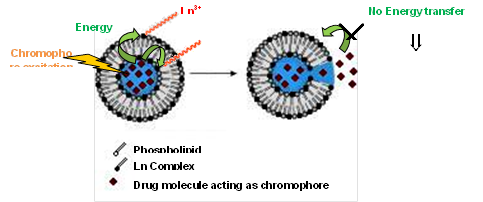Particles Comprising Luminescent Lanthanide Complexes
Référence
04400-01
Mots-clés
Statut des brevets
European priority patent application n° 13305291.0 filed on 14/03/2013 and entitled “Particles comprising luminescent lanthanide complexes”


Inventeurs
Eva JAKAB TOTH
Sara LACERDA
Célia BONNET
Stéphane PETOUD
Statut commercial
Open for Exclusive or non-exclusive license
Laboratoire
Centre de biophysique moléculaire (CBM, UPR4301), Orléans, France
Description
CONTEXT
Liponanoparticles (liposomes, synthetic lipoproteins, etc) have been widely explored as drug delivery devices; one example is Doxil, the clinically used liposome formulation of doxorubicin. Nevertheless, the in vivo, real time follow-up of drug release from these particles by imaging techniques remains an important challenge. The invention covers the design and the preparation of novel theranostic lipoparticles (liposomes, lipoproteins or other nanoparticles) which allow the visualization of drug release by optical imaging.
TECHNICAL DESCRIPTION
Among the different constituents that may build up these liponanoparticles, amphiphilic luminescent lanthanide complexes and a drug molecule have to be present. Depending on their lipophilic properties, the incorporated drug molecules may be localized either in the lipidic bilayer or in the aqueous core of the particles. In order to observe the luminescence of lanthanide complexes, the presence of a chromophore (antenna) is required that is capable of absorbing the excitation energy and transferring it to the lanthanide. Our invention consists of using the drug molecules to act as an antenna for the lanthanide luminescence. As a consequence, the release of the drug from the liponanoparticles will lead to the change of the luminescence signal thus allowing a direct follow-up of the drug release. Many anti-cancer agents contain a conjugated aromatic system and are capable of sensitizing lanthanide luminescence. For those drugs, we propose to create innovative image-guided therapies exploiting optical imaging based on drug-sensitized luminescence.

The drug acts as an antenna to sensitize lanthanide luminescence. The proximity of the drug and the lanthanide is a prerequisite for sensitization. As soon as the drug is released from the particle, this condition is not met any more, leading to the decrease of lanthanide luminescence.
DEVELOPMENT STAGE
Proof of concept has been obtained with doxorubicin and mitoxantrone in liposome formulations containing amphiphilic Ln3+ complexes which emit in the near IR. These particles have been detected in vivo in mice with fluorescence optics of a macroscope. The excitation wavelengths for doxorubicin, 600 nm, and for mitoxantrone, 660-700nm, are compatible with biological applications.
BENEFITS
In both imaging and drug delivery, the control of the in vivo integrity of the liponanoparticles and the monitoring of the release of the drug at the site of interest remains a challenge and calls for innovative in vivo imaging applications. We propose a fundamentally novel optical imaging approach to address this unmet need by exploiting sensitized lanthanide luminescence.
For further information, please contact us (Ref 04400-01)
Besoin de plus d'informations ?
Nous contacterTechnologies Liées
-
16.02.2018
Persistent luminescence nanoparticles excitable in situ for in vivo multimodal optical/MRI imaging and theranostics
Diagnostic médical 86609-04
-
20.07.2017
AequorinXS and Redquorin XS, new generation of blue and red-light emitting biosensors with extra sensitivity to calcium and improved bioluminescence intensity
Diagnostic médical 07370-01
-
15.02.2017
Large size and high quality graphene on silicium
Matériaux – Revêtements, Autres technologies 04490-01